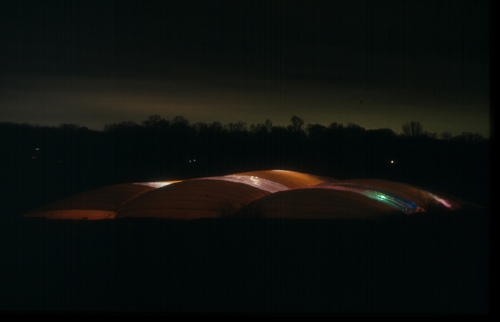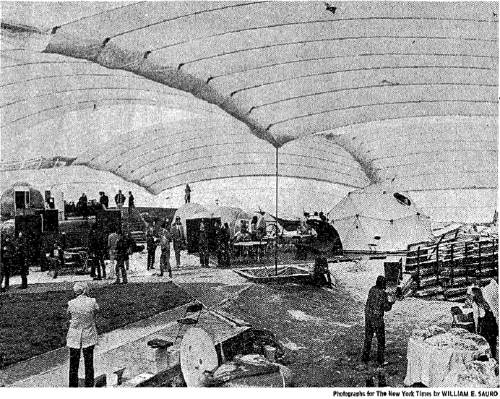
Domes, inflatables, World Expos, Buckminster Fuller, every once in a while around here, it feels like I’m just blogging about whatever artist Steve Roden blogged about three years ago.
The Antioch Bubble is one of those times. [Though, to my credit, I was within range in Feb. 2008]
After its main Ohio campus was shut down by a student strike, Antioch College began establishing satellite campuses around the country. The school’s hands-on, experiential learning approach lent itself to the development of a giant, one-acre bubble structure in Columbia, Maryland to house administration, classes, and other student activities. There were domes and other bubbles inside the 32,000 sf Bubble.

Considering they’re mostly used for tennis courts and sports stadiums now, it’s interesting to how politically polarized this inflatable structure concept had once been. Ant Farm was promoting inflatable lounges for naked hippies at Altamont at the same time the USIA was building a giant, balloon-roofed pavilion for the Osaka World Expo. And at the center of a master-planned real estate development of a city, Activist/architect Rurik Eckstrom was ranting against evil corporations from his Ford Foundation-funded dome.
The Antioch Bubble was contemporaneous with it all; there was a full model and 1,000sf mockup in the bag by 1971, and the real thing started going up in the Fall of 1972. An early Nor’easter flattened it in November of ’73. Design and construction were overseen by Ekstrom, an architecture professor at UMD, and a team of 15 students.
It’s still blowing my mind a little bit that such a radical-sounding guy as Eckstrom could be spearheading a truly experimental program to rebuild America’s schools, and with widespread institutional support. And at the same time that Popular Science is announcing the Glorious Inflatable Future has arrived, and we’ll all soon be living in Goodyear houses. PopSci called it “Antioch’s one-acre Pneumatic Nomadic Campus,” and touted its inexpensive portability.
From a NY Times article on May 26, 1973 [interior photo above], it appears a bit of the educational/collaborative value of the project was lost in a rushed to complete in time to host the National Conference on Air Structures in Education, which sounds like an event created to tap a funding source:
[Student/designer/participant Mike Krinsky] said he came here in January because he thought Antioch and the bubble project might help him learn to become a “competent activist.” He said he had become, instead, a poorly paid day laborer. “I’m leaving right now feeling I’ve been used.”
An important lesson for the interns of the future.
On the bright side, when Roden posted about Antioch in 2007, there was almost nothing online about it, or about Ekstrom. That has now changed. Factory School is building an archive of historical material and first-person accounts of the Bubble, which is being helped along by the likes of Google Books.
And the DC area may see another Pneumatic Event Space yet. If the Hirshhorn’s DS+R courtyard-filling donut bubble comes to fruition, the inflatable future may yet be upon us.
[2o22 update] While the fate of Factory School’s update is unclear, I did just receive an amazing first-person account of The Bubble from Richard Benjamin:
I worked and semi officially lived in The Bubble for about a year. It was great experience. The basic idea was sound, improvisation is what kept it up. The building was fairly (tolerably?) comfortable in Spring and Fall, scaldingly hot in summer, and numbingly cold in winter. The Bubble had heating and AC, both proved a bit inadequate if memory serves…but neither were used much due to huge spikes in energy costs not anticipated by the builders. The building didn’t require a lot electric power to stay inflated…if the wind blew in the right direction you could turn off the fans. You just opened an airlock on windward side and that produced enough pressure to keep the building inflated-with a bit more sway and sag than normal.Climbing along the main roof cables was a lot of fun. The building rocked up and down in the slightest breeze. We did a lot of climbing because the thin skin required constant patching. You sat of an inflatable mattress to make repairs…quite high above the ground, but you didn’t notice unless you were over the clear skin sections. If you fell through it would likely kill you. Nobody fell…not for lack of trying. The Bubble was located near an outdoor music venue, and music goers would not infrequently wander over to have a look. The more inebriated would decide to climb up one of the main cables. Sometimes wearing high heels. When they encountered the clear sections and realized they were maybe three stories off the ground, they would freeze in place. A rescue team with an air mattress would be sent topside to shove them to safety.A couple of years after the Bubble went down in a fading hurricane, I went to Syracuse University to get Ph.D. in biology. Syracuse had a brand new stadium with an air supported dome. I’d sit high in the cheap seats and think “yeah, I had a part in making this fad possible.”
Epic. Thank you for your service.
Event Architecture [airform archive]
Learning from Antioch – Columbia [factoryschool.com at the internet archive, rip]
